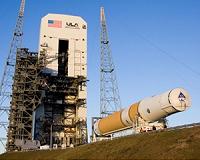 |
Pasadena CA (JPL) Feb 24, 2010 Will 2010 be the warmest year on record? How do the recent U.S. "Snowmageddon" winter storms and record low temperatures in Europe fit into the bigger picture of long-term global warming? NASA has launched a new Web page to help people better understand the causes and effects of Earth's changing climate. The new "A Warming World" page hosts a series of new articles, videos, data visualizations, space-based imagery and interactive visuals that provide unique NASA perspectives on this topic of global importance. The page includes feature articles that explore the recent Arctic winter weather that has gripped the United States, Europe and Asia, and how El Nino and other longer-term ocean-atmosphere phenomena may affect global temperatures this year and in the future. A new video, "Piecing Together the Temperature Puzzle," illustrates how NASA satellites monitor climate change and help scientists better understand how our complex planet works.
Piecing Together the Temperature Puzzle The video, "Piecing Together the Temperature Puzzle," explores possible causes for rising global temperatures. It explains what role fluctuations in the solar cycle, changes in snow and cloud cover, and rising levels of heat-trapping greenhouse gases play in contributing to global warming. The new gallery consists of ten spectacular satellite images of our warming planet captured during the hottest decade since modern record keeping began. The images show the kinds of events - including melting glaciers, heat waves, and floods - that many scientists predict will become more frequent in coming decades due to climate change. Both the video and the image gallery are part of a new multimedia collection available with the launch of the "Our Warming World" Web page on NASA's Global Climate Change Web site. "Our Warming World" features videos, images, articles and interactive visuals that discuss rising global temperatures and the impact of greenhouse gases as the main contributor to today's climate change.
Share This Article With Planet Earth
Related Links NASA's Global Climate Change Web site Earth Observation News - Suppiliers, Technology and Application
 NASA And NOAA Ready GOES-P Satellite For Launch
NASA And NOAA Ready GOES-P Satellite For LaunchGreenbelt MD (SPX) Feb 23, 2010 NASA is preparing to launch the NOAA Geostationary Operational Environmental Satellite-P (GOES-P) from Space Launch Complex 37 at the Cape Canaveral Air Force Station, Fla. The launch is targeted for March 2, during a launch window from 6:19 to 7:19 p.m. EST. "GOES are the backbone of NOAA's severe weather forecasts, monitoring fast-changing conditions in the atmosphere that spawn hurrican ... read more |
|
| The content herein, unless otherwise known to be public domain, are Copyright 1995-2010 - SpaceDaily. AFP and UPI Wire Stories are copyright Agence France-Presse and United Press International. ESA Portal Reports are copyright European Space Agency. All NASA sourced material is public domain. Additional copyrights may apply in whole or part to other bona fide parties. Advertising does not imply endorsement,agreement or approval of any opinions, statements or information provided by SpaceDaily on any Web page published or hosted by SpaceDaily. Privacy Statement |